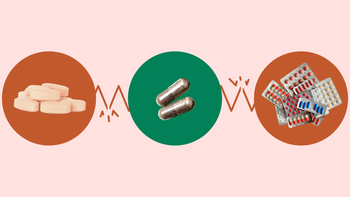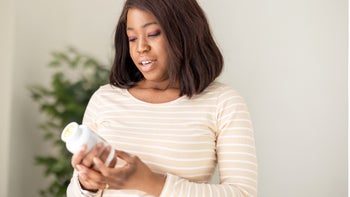
Does Cranberry Juice Help With a UTI?
Key takeaways:
Cranberry juice and cranberry capsules have been used for years to help reduce the symptoms of UTI. But the data to support the use of cranberry juice as a treatment for UTI is lacking.
There’s some evidence suggesting cranberry juice might help prevent UTIs in people who have recurrent UTIs.
If you suspect you have a UTI, you should see your healthcare provider. UTIs almost always need to be treated with antibiotics since they can turn into more serious infections.
You’ve probably heard by now that cranberry juice can help with urinary tract infections (UTIs). But is this true? Is cranberry actually good for treating or preventing UTIs? Let’s take a closer look at whether cranberry juice or cranberry pills can help with UTI symptoms and if not, how you can treat it.
Cranberry juice for UTI: Myth or reality?
It’s not clear whether cranberry juice or pills can really help prevent or treat a UTI. The data is mixed. One study of older adults looked at people who were at risk for getting UTI compared with people who weren’t at risk.
Some of the people in each group got cranberry pills and some got a placebo (sugar pill). Interestingly, the people at risk for a UTI who got cranberry pills had fewer UTI symptoms. But there was no difference in actual UTI diagnosis using a urine culture to confirm the presence of bacteria. In the low-risk group, there was no difference in UTI symptoms or the presence of bacteria on urine culture.
Search and compare options
The researchers concluded that if a person is at increased risk, taking cranberry pills might lower the incidence of UTI symptoms. But this evidence is weak.
What cranberry juice or pills are best for UTI prevention?
Among the studies that have looked at cranberry as UTI prevention, there’s a lot of variation in what type of cranberry products were used. For that reason, it’s difficult to say if taking cranberry pills for UTI is better than cranberry juice.
When cranberry juice is studied, it’s usually a higher concentration than the cranberry juice cocktail at your grocery store. The taste of pure cranberry juice typically turns people off, so the commercial versions are sweetened. That being said, pure cranberry juice may be better than sweetened cranberry juice for preventing UTI.
You can also find dried cranberry powder in capsule or tablet form. But, you’ll want to be careful when taking cranberry supplements for UTI. They’re not regulated, and dosing may not be consistent.
How much cranberry you need for UTI prevention hasn’t been established. But many studies have shown that 36 mg of proanthocyanidins (PAC) is the recommended intake for cranberry products to have an effect. Many cranberry supplements contain much less than that and aren’t likely to help with UTI at all.
Be sure to speak with your healthcare provider before taking anything new — including cranberry supplements. This will be important especially if you take other medications or are pregnant or breastfeeding.
Read more like this
Explore these related articles, suggested for readers like you.
Where does the claim that cranberry juice helps with UTIs come from?
It’s believed that cranberries were first used for medicinal purposes by Native Americans. In the late 1800s, scientists discovered that cranberry juice could lower the pH of urine (making it more acidic). It was thought that a low pH of urine could also prevent the growth of bacteria, including E. coli — the most common cause of UTIs.
Research has found that proanthocyanidins in cranberries may prevent E. coli from sticking to the cells of the urinary tract.
UTI treatment options
Treatment of uncomplicated UTIs requires antibiotics. It’s important to treat a UTI promptly to avoid more serious issues, like kidney infection. Some of the antibiotics that are most frequently used include:
Sulfamethoxazole/trimethoprim (Bactrim, Septra)
Nitrofurantoin (Macrobid, Macrodantin)
Ciprofloxacin (Cipro)
Levofloxacin (Levaquin)
Your healthcare provider will take into account your entire clinical picture when prescribing an antibiotic. The right antibiotic for you will depend on a number of factors, including:
What bacteria is causing your infection
Your age
Whether the area you live in has a high antibiotic resistance rate
Whether you have allergies/sensitivities
How often you get UTIs
Rarely, a UTI might go away on its own. It’s hard to predict which ones will, though. And some untreated UTIs will turn into a more complicated infection. That’s why it’s always best to let your healthcare provider know if you have UTI symptoms.
UTI prevention tips
Cranberry juice may or may not help prevent UTIs. But there are four things you can do at home to help prevent a UTI:
Urinate after sex. This helps to wash bacteria from the urethra so they can’t make their way up into the bladder.
Stay hydrated. Good hydration means you pee often, and this will help ensure that you regularly wash away bacteria from the urethra.
Wipe from front to back after you pee. This might prevent introducing bacteria from the rectal area into the urethra if you’re at high risk.
Look into different birth control options. There isn’t any evidence that hormonal birth control causes UTIs. But spermicides may increase the risk. If you have recurrent urinary infections, you might consider switching your birth control.
The bottom line
If you currently have a UTI, the best treatment is antibiotics. Cranberry juice and other cranberry products aren’t recommended as treatments because there isn’t any evidence that it works. The research on whether cranberry juice can help with UTI prevention is mixed. But the good news is, it may be worth considering for people who struggle with recurrent UTIs. If you’re looking for ways to help treat or prevent UTIs, talk with your healthcare provider for guidance on the best options for you.
Why trust our experts?


References
Raz, R., et al. (2004). Cranberry juice and urinary tract infection. Clinical Infectious Diseases.
Howell, A., B., et al. (2005). A-type cranberry proanthocyanidins and uropathogenic bacterial anti-adhesion activity. Phytochemistry.
Jepson, R. G., et al. (2012). Cranberries for preventing urinary tract infections. Cochrane Database of Systematic Reviews.
Wang, C., et al. (2012). Cranberry-containing products for prevention of urinary tract infections in susceptible populations. Journal of the American Medical Association Internal Medicine.
National Center for Complementary and Integrative Health. (2020). Cranberry.





























